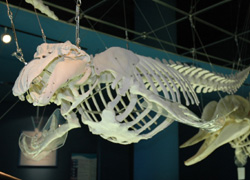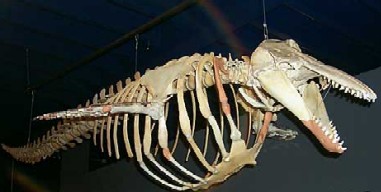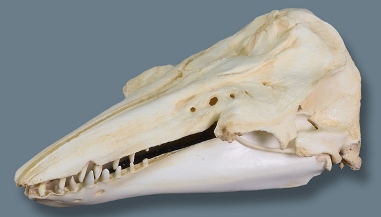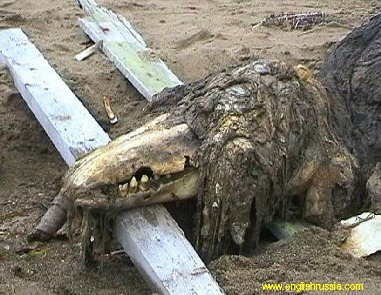More on the Russian Plesiosaur
Posted by: Craig Woolheater on August 29th, 2006
Have the readers of Cryptomundo correctly identified this mystery carcass?
While I initially thought that the "Russian Plesiosaur" looked crocodilian in origin, I agree with the majority of the commenters here on Cryptomundo that the carcass looks like it is that of a whale, most likely a beluga.
Below are some photos of beluga skeletons that I have found on the internet.
This is a replica beluga whale skull available from Skulls Unlimited. Below that is a close-up of the "Russian Plesiosaur" skull.
Click on image for full-size version
Click on image for full-size version
As noted by many Cryptomundo readers, they look very similar.

Click on image for full-size version



Source for above photo: Alaska Museum of Natural History.
About Craig Woolheater
Co-founder of Cryptomundo in 2005.
I have appeared in or contributed to the following TV programs, documentaries and films:
OLN's Mysterious Encounters: "Caddo Critter", Southern Fried Bigfoot, Travel Channel's Weird Travels: "Bigfoot", History Channel's MonsterQuest: "Swamp Stalker", The Wild Man of the Navidad, Destination America's Monsters and Mysteries in America: Texas Terror - Lake Worth Monster, Animal Planet's Finding Bigfoot: Return to Boggy Creek and Beast of the Bayou.












The mystery carcass is definitely a whale of some kind. Whether it’s a beluga or not is open to debate. The jaws seem somewhat broader and heavier than the beluga’s. And the teeth do seem more molar-like, as in an archaic whale, but from the pic it’s hard to be sure.
Prominent in the “plesiosaur” photos is what appears to be a shoulder blade. That would match up pretty well to the photos you have here.
Thanks for helping with the direct comparison. I think it shows both the similarities and differences pretty well.
It always amazes me that people see something that they can’t easily idnetify and jump right to the more incredible explanations- prehistoric whales, reptiles, etc- without doing even a modicum of research and analysis to eliminate the more mundane possibilities.
Occam’s Razor, folks- use it.
Yes…being able to directly compare does help. I think that if you look at the contours of the debris on the skull, you can see it draping over structures that match position and shape of the protruding ‘arches’ on the beluga skull. Are those remnants of the orbits? In any case, it just adds, to me, to the probability that tis was indeed a cetacean.
I’ve been very pleased to see the people on this sight doing such good research and following up on this thing. Some very intelligent and well thought out ideas on this intriguing topic.
Like MadMatt32171 says, we cannot just jump to the conclusion we want, but must instead investigate all known possibilities before saying this is some ancient prehistoric animal.
I would really have liked this to have been a cryptid, but we have to be ready for the distinct possibility that is is just a whale.
I sure would like to see any DNA tests they do on this thing.
Also, some of the minor differences between the mystery animal and the skeleton pics such as broadness of snout could be explained by individual differences between animals. Not all skulls from a given species are going to look absolutely 100% the same.
Great topic.
I’m also glad to have found the “skulls unlimited” site- they even have replica Gigantopithecus Blacki skulls and jaws.
thanks, jeff
This site has taught me just how ignorant I was of the true nature of cryptozoology.
I read a lot but my thinking wasn’t as it should be.
I’ve learned a lot from all the folks on here and I continue to do so daily.
Thank you all. I’m having a whale of a time learning from you 🙂
The nose end of the skull doesn’t quite match up with any of the other skulls, particularly the belugas.
That mystery skull looks like a spot on match to the beluga skull pictured above it to me. It even looks like that seaweed crud is hanging off of those cranial projections on the side. I don’t see any differences that could not be explained by individual genetic variation or the state of its deterioration. I would really like to see the “plesiosaur” skull without all that stuff attached to it.
Also, what looks like flattened molars look a lot like the teeth were just broken off. Or perhaps worn down? Maybe this was an elderly specimen? Maybe that’s why it died? The teeth are wierd but not to the point of discounting the similarity to that beluga skull, I feel.
I still think it’s merely a sturgeon.
Another mystery bites the dust. Next please.
Were samples with usable DNA taken? It’s definitely whale-like, but it would be good to verify what kind.
Long time reader first time poster. I like the beaked whale idea and think that it may be a False Killer Whale by the looks of this skull.
It’s not a beluga whale. I’ll show you my prehistoric whale book and show the many different types of whales and sea dinos.
Remember there’s more parts of the body being covered up by seaweed and other debris.
To solve this lets get a DNA test on this animal so see who’s right and who’s wrong.
Yes, it looks like a DNA sample is the only way anybody’s going to be happy with the outcome of this. That is if anyone has the presence of mind to do a DNA test at all.
How many corpses like this have been discarded without one?
I’d actually like to see some of those prehistoric whale skull photos compared to this one, crypto_randz. It might add a new spin on the discussion.
For now, I’m just seeing that it looks very much like that beluga skull to me.
My first choice was a Mosaurus. I never thought it looked like a pleisosaur. I’ve done alot of research on sea dinos and lake dinos.
I’m hoping this would prove some dino cryptids might have survived.
To me it looks more like a lizard, but I feel I’m entitled to my opinion just like you, so therefore I don’t think its a beluga whale.
A debate, I like this.
Absolutely it may be something other than a beluga whale. It could be a lot of things, and I think your opinions are valid. I just have not found any evidence that stands up better than what I see when I look at that skull comparison.
I’m not being sarcastic when I say that I really would like to see a comparison against prehistoric skulls.
If I saw something that was compelling enough, I would certainly consider it.
I am just a scientific minded individual and I like to get the facts and see the possibilities before jumping to conclusions.
If I saw something to make me think this was a dinosaur, great.
But I am not seeing anything to lead me to that conclusion yet.
One thing that could help would be an examination of the neck vertebrae. The beluga is supposedly the only whale which does not have fused neck vertebrae, so it can turn its head to some degree.
The false killer whale and even the pilot whale seem to be real possibilities.
One thing about the beluga whale, are they close to the zeuglodon?
I haven’t read much on the beluga whale. I’m going to let my dad take a look at the photos.
My dad spent most of his life on lakes and seas, doing a lot of fishing. I know the mosaurus and basilosaurus are ancient whales.
They need to take the seaweed and debris off the carcass so the photos have clear view of the whole animal.
I’ll accept the zeuglodon.
If it’s a beluga whale, then I’ll admit the photos were misleading.
The Beluga skull is a close match for sure! This animal could be of a different gender from the beluga skull pictured and alot older individual.
I think that that tail vertebrae are somewhat more keeled than a Beluga and the total lack of a tail fin is also a problem.
As I recall there are a slew of extinct marine reptilian skulls repro’s on the “skulls” site as well for further comparisons.
Wayne
What in these pictures suggests a prehistoric whale? The skull alone has three key features that are found in the beluga skull:
1) The “notch” in the upper jaw
2) The “holes” in the lower jaw opposite from the notch.
3) The midline ridge.
As for missing fins, etc, this thing has obviously been decaying for some time- things like flukes and dorsal fins that don’t have directly supporting skeletal structures are the first to rot/fall/be eaten off of a carcass. Again, aside from wishful thinking, there’s nothing in this set of pictures that suggests anything other than a badly decomposed beluga or similar toothed whale.
Missing fins could definitely be explained by the decomposition of the carcass. Same goes for the tail.
Of course there is a possibility it didn’t have fins.
I’m just saying that lack of fins or tail do not a prehistoric monster make.
I would be excited if was a Mosaurus, it would prove that some ocean dinosaurs aren’t exinct.
As a Fisheries biologist, and having seen my share of dead, decayed whales and dolphins, I’m very inclined to think this is certainly an odonocete. As for the “seaweed, algae stuff”, when whale tissue starts to decompose, it reveals a sinuey type structure, which often times resembles matted hair or fur. It then often gets reddish brown algae growing on it. I’m surprised the gov. fisheries organization (do they have one in Russia?) isn’t all over this. Whenever a cetacean washes up here, my collegues at NMFS are on it collecting samples, taking the bones back to Wood’s Hole, etc. And the stench is absolutely unbelievable. It is the worst smell I’ve ever encountered. Thats my 2 cents.
I just showed my dad the photos of the sea animal he thinks it could be a saltwater crocodile or eel, than he told me might be a mixed breed of crocodile, he has spent his life fishing on lakes and oceans he has experience, he was really amzed by the photos, my dad has good judgment so thats what he thinks the animal could be.
I think the general public is fairly uninformed about how strange skeletons of common animals look, and would therefore believe almost anything about
the identity of any given skeleton. Up in Maine we had a dead dog making supposedly normal people scratching their heads which left me …scratching my head.
It’s very common for people- even people familiar with the sea and it’s critters- to see the skeletal remains of a toothed whale and think that it looks more reptilian than mammalian. Once the blubber’s gone, particularly the “forehead” region of the head, the proportions that everyone is used to get so radically altered that it no longer resembles a whale.
So, no offense to your dad, Randz, but I’ll go with the fisheries biologist with this one.
The rancid stench would certainly explain why these gentlemen didn’t remove all that rotting tissue from it when they took these photos.
Good observation MadMatt good information. I needed another opinion to the animal being observed, my dad has fished on many lakes and oceans but he knows his fish and other animals of the sea, the carcass is misleading it looks like it could be anything . It truly is quite a specimen.
It really could be a lot of things. When a corpse gets to this stage of decomposition it gets very hard to identify by photos alone. Globsters are a good example of this. Quite a few of them have turned out to be caused by known animals but you would never know by just looking at some of them. Basking sharks, whales, etc, can get pretty unrecognizable at the latter stages of decay. Lots of good ideas coming out about these photos, everyone.
I know I agree great observations on this mystery carcass everyone.
I keep going back to look at the photos. This subject seems neverending.
They probably won’t do an DNA. Am I correct?
It could have died of old age, unless it was attacked by a predator.
mystery man you have good knowledge and you have done your homework, well done.
A whale beluga, zeuglodon, mmmm possible, or hopefully a mosaurus.
Wishful thinking on my part. I’ll just keep my fingers crossed.
I’m wondering about that DNA test myself. I think they probably would do one, unless some one looked it over and were so sure of what it was that they decided a DNA test wasn’t needed. Or if the stink was so great they just discarded it. That wouldn’t be the first time a potential exciting discovery had been thrown away cause of the stink. As the fisheries biologist above mentioned, normally there would have been people all over this, so I’m wondering what kind of scientific integrity is being exercised when dealing with this thing. If a DNA test is performed, I for one would sure like to see the results, just to be sure.
All this has forced me to register.
With all this very expert sounding input it’s hard to think it’s a plesiosaur.
But why don’t we look at plesiosaur fossils.
I just googled that, and they look pretty close.
I’ll give you whale guys 79%, but I’m holding out for the other 21%, call me a dreamer.
One thing that could support this as being a cryptid is the idea of “convergent evolution”, the idea that two totally different species will evolve in similar ways to fill similar ecological niches or habitats. For example, a shark and dolphin have similar body shapes and contours for living in the water. If this creature is some hitherto unexplained animal, the fact that it looks so much like a beluga, yet a bit off as some people have been saying, could be because it has evolved to fill a very similar biological niche as the beluga and thus would have evolved along similar lines. Just a thought.
You can fool most of the people some of the time, and some of the people most of the time. But nothin’ gets by Loren, Craig, John, Rick and the Crypto Kids.
crypto_randz:
I agree that most likely there are surviving mosasaurs, but this just isn’t it. Take away the skull damage and sea weed and you’ve got a beluga skull. If you want a mosasaur, look at the Mystery Fish. A clear cut case of a shell crunching mosasaur.
P.S. Plesiosaur skulls, to the untrained eye, are similar. You can’t just Google something and claim authority. I’m glad new readers are joining, but try intensive research next time, nacho.
This is the first time I’ve commented on Cryptomundo. These pictures are thought provoking and indeed mysterious. But I must point out that the skull is a beluga skull, and either way the supposed fur seems darker in some places. I also believe that these photos portray a mix of several skeletons, with some whale blubber on top. The one way to sort this out for good is to dissect the carcass, and if the soldiers or fishermen, or whoever they may be, deny scientists their permission to do so, they obviously are hiding something.
I am not against animals that were once thought to be extinct, being found alive. It has actually happened several times as I am sure many in here are well aware. Despite this, the fact that so many could mistake a obvious toothed whale for a plesiosaur amazes me.
If you have an interest in such things, it may help to educate yourself on the anatomy of the animals you are looking at. It is like the other supposed plesiosaur found by the Japanese where they took numerous pics and then threw the carcass overboard. This was an obvious shark, and I know this because I have dissected enough of them to recognize them rather quickly, even in such a decayed state.
By studying anatomy, we see things that can bring about quite a surprise. Anatomy showed us, not only things like the coelacanth, where a group of supposed extinct sarcopterygians were found still alive and well in deep waters, but facts like birds are left overs of the theropod dinosaurs, and in fact are living dinosaurs. Comparative anatomy is also showing us that there is a high probability that the monotremes, as in the echidna and duck-billed platypus, are actually surviving members of a group of mammals known as the Multituberculates that were once said to be extinct for millions and millions of years.
Basically put, it is fun to wonder, but knowing the anatomy helps one check the facts against a known, and helps reduce idle speculations that should not even taken place when such an obvious whale is found.
PS
I forgot to mention I have dissected whales as well (a Blue whale actually) so I am familiar with whale anatomy too…
I think Lagomort is correct. I saw a living fossil shark on TV before. It looks eel like. It had many sharp long teeth. It was found slowly drifting in the shallow waters off Japan. That’s near to the Russian site. This shark is usually found in deep sea waters. I’m just a layman.
I agree with many that the Beluga is close but the last few vertebrae seem different as well as the spread of the head. There are of course subtle differences in on specimen to another but the vertebrae are too different in my opinion to not warrant further investigation, that is if I could.
Love the site, keep up the good work!
This is my first comment on CryptoMundo. In my opinion, this definitely looks a whole lot like a Beluga Whale, to me. The shape of the skull looks almost identical, except for a few minor differences. However, I think that these differences could just be explained by individual variation, as has been mentioned, before. However, I must say that I am very surprised that someone could possibly mistake this carcass for a plesiosaur! When I first saw the pictures, at first, I thought it looked like some sort of crocodilian. However, when I compared it to the picture of the Beluga skull, I then realized that it was most probably some type of Whale. I am not 100% sure that it is a Beluga Whale, however, but it is definitely some kind of Whale.
But, I am still very shocked at how somebody could possibly mistake this for a plesiosaur! I do think that it is possible for plesiosaurs to have survived to modern times, but I just don’t think that this carcass looks anything like a plesiosaur, whatsoever!